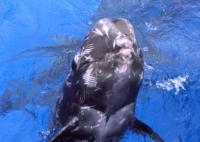 |
 Distribution Map
Distribution Map(Click for larger version) |
Risso's Dolphin
|
 A Risso's Dolphin
A Risso's Dolphin
From the NUS Dolphin Study Group Etienne Douaze <douaze@dsg.sbs.nus.edu.sg Permission obtained on 30 July 1998, Email message. |
Although the Risso's dolphin has a wide distribution, it is not particularly well known anywhere. It has been neglected somewhat by researchers. The Risso's dolphin's range includes tropical and warm temperate waters across the world, often deeper than 1000 meters. Specimens are normally around 2.7 to 2.8 meters long, with some individuals reaching 3.8 meters. The Risso's dolphin has no beak, a rounded body, a high, flacate dorsal fin, and scratch marks all over the body. There is much variation in color, ranging from white to almost black. The variation does not appear to have a geographic correlation, as both light-colored and dark-colored specimens are found in the northern Bahamas. There are white areas of various sizes on the belly. A feature unique to the Risso's dolphin is a vertical crease on the melon. The structure of the teeth is very unusual for dolphins. There are two to seven pairs of teeth on the lower jaw, and almost never any teeth on the upper jaw. In addition, the teeth are not evenly distributed. The teeth on the lower jaw are worn down, which is perplexing, since wearing is usually caused by the movement of the teeth against one another, but that is not possible when there are no teeth on the upper jaw. In some ways, the Risso's dolphin resembles the pilot whale, but the position of the dorsal fin, the coloration, and several other features are notably different. The body and brain weight are similar to those of the bottlenose dolphin. Behavior appears to be quite playful, with inidividuals having been seen leaping out of the water. Schools appear to consist of 50 to 60 individuals. The Risso's dolphin is a squid eater.
The best known Risso's dolphin, indeed one of the best known cetaceans of all time, was an individual named Pelorus Jack who inhabited Cook Strait in New Zealand roughly between 1888 and 1912. Although usually refered to as male, his gender was not known. Being the only one of his kind in the region, he associated with ships, accompanying steamers and becoming a famous tourist attraction. Possibly in search of security, he seemed to prefer fast ships. Pelorus Jack became so popular with the public that, in 1904, when someone decided to try to shoot him, a law was passed in New Zealand that banned shooting any Risso's dolphin in Cook Strait. When he died in 1912, all of New Zealand mourned his death. There was some debate as to whether Pelorous Jack was truly a Risso's dolphin, but his species was confirmed in 1974 by the analysis of a 1907 photo.
|
|
|
|
|
![]()
Bibliography
Baker, Mary L. Whales, Dolphins, and Porpoises of the World. New York: Doubleday & Company, Inc., 1987.
Carwardine, Mark. Eyewitness Handbooks: Whales, Dolphins, and Porpoises. New York: Dorling Kindersley Ltd., 1995.
Ellis, Richard. Dolphins and Porpoises. New York: Alfred & Knopf, Inc., 1982.
Klinowska, Margaret. Dolphins, Porpoises, and Whales of the World: The IUCN Red Data Book. Gland, Switzerland: World Conservation Union, 1991.
|
© 1998 Thinkquest Team 17963 <17963@advanced.org Modified: 30 August 1998, Created: 30 June 1998 |
